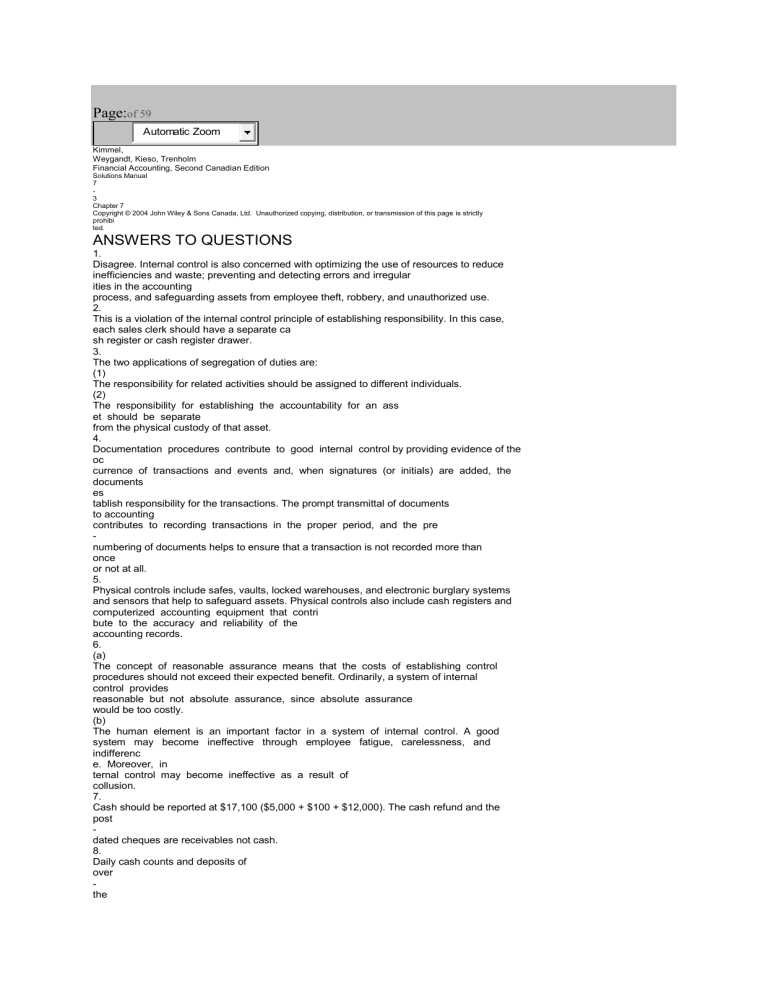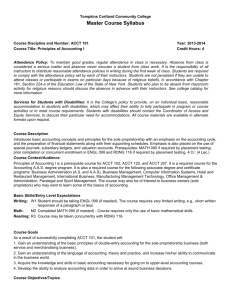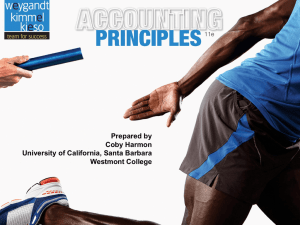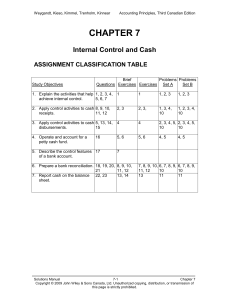
Page:of 59 Automatic Zoom Kimmel, Weygandt, Kieso, Trenholm Financial Accounting, Second Canadian Edition Solutions Manual 7 3 Chapter 7 Copyright © 2004 John Wiley & Sons Canada, Ltd. Unauthorized copying, distribution, or transmission of this page is strictly prohibi ted. ANSWERS TO QUESTIONS 1. Disagree. Internal control is also concerned with optimizing the use of resources to reduce inefficiencies and waste; preventing and detecting errors and irregular ities in the accounting process, and safeguarding assets from employee theft, robbery, and unauthorized use. 2. This is a violation of the internal control principle of establishing responsibility. In this case, each sales clerk should have a separate ca sh register or cash register drawer. 3. The two applications of segregation of duties are: (1) The responsibility for related activities should be assigned to different individuals. (2) The responsibility for establishing the accountability for an ass et should be separate from the physical custody of that asset. 4. Documentation procedures contribute to good internal control by providing evidence of the oc currence of transactions and events and, when signatures (or initials) are added, the documents es tablish responsibility for the transactions. The prompt transmittal of documents to accounting contributes to recording transactions in the proper period, and the pre numbering of documents helps to ensure that a transaction is not recorded more than once or not at all. 5. Physical controls include safes, vaults, locked warehouses, and electronic burglary systems and sensors that help to safeguard assets. Physical controls also include cash registers and computerized accounting equipment that contri bute to the accuracy and reliability of the accounting records. 6. (a) The concept of reasonable assurance means that the costs of establishing control procedures should not exceed their expected benefit. Ordinarily, a system of internal control provides reasonable but not absolute assurance, since absolute assurance would be too costly. (b) The human element is an important factor in a system of internal control. A good system may become ineffective through employee fatigue, carelessness, and indifferenc e. Moreover, in ternal control may become ineffective as a result of collusion. 7. Cash should be reported at $17,100 ($5,000 + $100 + $12,000). The cash refund and the post dated cheques are receivables not cash. 8. Daily cash counts and deposits of over the counter receipts pertain primarily to the principles of segregation of duties and independent in ternal verification. Daily cash counts also involve the establishment of responsibility for performing the counts. Kimmel, Weygandt, Kieso, Trenholm Financial Accounting, Second Canadian Edition Solutions Manual 7 4 Chapter 7 Copyright © 2004 John Wiley & Sons Canada, Ltd. Unauthorized copying, distribution, or transmission of this page is strictly prohibi ted. Questions (Continued) 9. Cash re gisters are readily visible to the customer. Thus, they prevent the sales clerk from ringing up a lower amount and pocketing the difference. In addition, the customer receives an itemized receipt, and the cash register tape is locked into the register fo r further verification. Having scanners reduces the chance of error in entering the price of an item. 10. Two mail clerks contribute to a more accurate listing of mail receipts and to the endorsement of all cheques “For Deposit Only.” In addition, two cle rks reduce the likelihood of mail receipts being diverted to personal use. 11. Segregating the duties surrounding the receipt, disbursement and recording of cash reduces the risk that employees could divert cash for personal use and cover up the theft by manipulating cash payments or by hiding any discrepancies through “creative” bookkeeping. 12. Payment by cheque contributes to effective internal control over cash disbursements. 13. The procedure and related principle are: Procedure Principle (1 ) Treasurer signs cheques Establishment of responsibility (2) Cheques imprinted by a computer Physical controls (3) Comparing cheque with approved Independent internal verification invoice before signing 14. A bank contributes significantly to inte rnal control over cash because it: (1) safeguards cash on deposit, (2) minimizes the amount of cash that must be kept on hand, and (3) provides a double record of all bank transactions. 15. The lack of agreement between the cash balances may be due to eit her: (1) Time lags – a cheque written in July does not clear the bank until August. (2) Errors – a cheque for $110 is recorded by the depositor at $101. 16. (a) An NSF cheque occurs when the cheque writer’s bank balance is less than the amount of the cheque. (b) In a bank reconciliation, a customer’s NSF cheque is deducted from the balance per books. (c) An NSF cheque results in an adjusting entry in the company’s books, as a debit to Accounts Receivable and a credit to Cash. Kimmel, Weygandt, Kieso, Trenholm Financial Accounting, Second Canadian Edition Solutions Manual 7 5 Chapter 7 Copyright © 2004 John Wiley & Sons Canada, Ltd. Unauthorized copying, distribution, or transmission of this page is strictly prohibi ted. Questions ( C ontinued) 17. Cash equivalents ar e considered to be “near” cash. Cash equivalents are highly liquid investments that may be converted to a specific amount of cash with maturities of three months or less when purchased. Cash equivalents are often reported with cash in the current asset sec tion of the balance sheet. 18. Compensating balances are minimum cash balances which lenders specify that a borrower must maintain in the borrower’s bank account to provide support for a loan. A compensating balance should be reported as a noncurrent as set and disclosed in the notes to the financial statements. 19. The basic principles of cash management are: (1) increase collection of receivables, (2) keep in ventory low, (3) delay payment of liabilities, (4) plan timing of major expenditures, and (5) invest idle cash. 20. The company will have to ensure that any excess cash, due to the increase in cash flows, is properly invested and not sitting idle in a bank account. 21. (a) A cash budget is a tool used to help planning for the company’s cash ne eds. It shows anticipated cash flows. (b) A cash budget contributes to effective cash management by enabling a company to plan ahead to cover possible shortfalls and invest idle funds. Kimmel, Weygandt, Kieso, Trenholm Financial Accounting, Second Canadian Edition Solutions Manual 7 6 Chapter 7 Copyright © 2004 John Wiley & Sons Canada, Ltd. Unauthorized copying, distribution, or transmission of this page is strictly prohibi ted. SOLUTIONS TO BRIEF E XERCISES BRIEF EXERCISE 7 1 The four purposes of internal control are to: 1. Optimize the use of resources to reduce inefficiencies and waste. An application for Plenty Parking is the use of automatic ticket dispensers at the entry gates and time clocks to determine how long vehicles have been parked. 2. Prevent and detect errors and irregularities in the accounting process. An application for Plenty Parking is to segregate responsibilities. For example, a different person (a manager or Gina as the owner) than the person who collects and deposits the cash should prepare the bank reconciliation. 3. Safeguard assets from theft, robbery, and un authorized use. An application for Plenty Parking is the use of a cash register to safeguard assets. 4. Maintain reliable control systems to enhance the accuracy and reliabi lity of its accounting records. An application for Plenty Parking is the comparison of the daily cash receipts to the cash register tape. All four purposes are important to the success of any business endeavour. BRIEF EXERCISE 7 2 (a) Segregation of du ties (b) Independent internal verification (c) Documentation procedures BRIEF EXERCISE 7 3 (a) Physical controls (b) Other controls (c) Independent internal verification (d) Segregation of duties (e) Establishment of responsibility (f) Other controls Kimmel, Weygandt, Kieso, Trenholm Financial Accounting, Second Canadian Edition Solutions Manual 7 7 Chapter 7 Copyright © 2004 John Wiley & Sons Canada, Ltd. Unauthorized copying, distribution, or transmission of this page is strictly prohibi ted. BRIEF EXERCISE 7 4 (a) Documentation procedures (b) Independent internal verification (c) Physical controls (d) Establishment of responsibility (e) Segregation of duties (f) Establishment of responsibility, segregation of duties and independent internal verification BRIEF EXERCISE 7 5 (a) Outstanding cheques – deducted from cash balance per bank (b) Bank service charge – deducted from cash balance per books (c) Interest paid by bank – added to cash balance per books (d) Deposit in transit – added to cash balan ce per bank (e) Bank error (deposit recorded twice) – deducted from cash per bank BRIEF EXERCISE 7 6 (a) The reconciling items per the books, items (b) and (c) above, will require adjustment on the books of the depositor. (b) The other reconciling items , deposits in transit, outstanding cheques and bank errors do not require adjustment because they have already been correctly recorded on the depositor’s books. Kimmel, Weygandt, Kieso, Trenholm Financial Accounting, Second Canadian Edition Solutions Manual 7 8 Chapter 7 Copyright © 2004 John Wiley & Sons Canada, Ltd. Unauthorized copying, distribution, or transmission of this page is strictly prohibi ted. BRIEF EXERCISE 7 7 Cash balance per bank ................................ ................................ .......................... $7,800 Add: Deposits in transit ................................ ................................ ......................... 1,700 9,500 Less: Outstanding cheques ................................ ................................ ................... 760 Adjusted cash balance per bank ................................ ................................ ............ $8,740 Cash balance per books ................................ ................................ ......................... $8,760 Less: Bank service charge ................................ ................................ .................... 20 Adjusted cash balance per books ................................ ................................ ........... $8,740 BRIEF EXERCISE 7 8 July 31 Bank Charges ................................ ................................ .... 20 C ash ................................ ................................ ....... 20 BRIEF EXERCISE 7 9 January outstanding deposits : Cash deposits per books, January $2,500 Less: Cash deposits per bank (2,300 ) Outstanding deposits $ 200 February outstanding deposits: Cash deposits per books, February $2,800 Less: Cash d eposits per bank (2,000) Add: January outstanding deposits 200 Outstanding deposits $1,000 BRIEF EXERCISE 7 10 November $650 ($9,250 $8,600) December $2,450 ($650 + $12,700 $10,900) Kimmel, Weygandt, Kieso, Trenholm Financial Accounting, Second Canadian Edition Solutions Manual 7 9 Chapter 7 Copyright © 2004 John Wiley & Sons Canada, Ltd. Unauthorized copying, distribution, or transmission of this page is strictly prohibi ted. BRIEF EXERCISE 7 11 Ouellette Ltée should report cash i n bank and payroll bank account as current assets. Plant expansion fund cash should be reported as a noncurrent asset, assuming the fund is not expected to be used during the next year. The compensating balance should also be reported as a noncurrent asse t and disclosed in the notes. BRIEF EXERCISE 7 12 (a) The Toronto Maple Leafs hockey team are likely to want to focus on how to invest idle cash. The hockey club likely sells tickets in advance and will want to invest the cash short term until such a ti me as it is needed to pay expenses such as players’ salaries. (b) Imperial Tobacco will likely want to keep inventory levels low to minimize the amount of cash tied up at any given time. (c) Intrawest Corporation has undergone major growth in its resorts over the past several years. Intrawest will likely want to plan the timing of major expenditures to ensure it has sufficient resources available to finance the expenditures. (d) WestJet Airlines has also undergone significant growth and is likely to need to plan the timing of major expenditures such as new planes. As well, the company may try to delay the payment of liabilities to ensure that large bills for items such as jet fuel and catering are not paid early and that when possible, all discounts are t aken. (e) The McMaster University Bookstore is likely to manage cash by delaying the payment of liabilities to publishing companies until the bills are due. As well, the bookstore probably generates most of its cash at the beginning of the semester and wi ll want to invest any idle cash. (f) Tim Hortons will likely want to keep inventory levels low to minimize the amount of cash tied up in perishable products. Kimmel, Weygandt, Kieso, Trenholm Financial Accounting, Second Canadian Edition Solutions Manual 7 10 Chapter 7 Copyright © 2004 John Wiley & Sons Canada, Ltd. Unauthorized copying, distribution, or transmission of this page is strictly prohibi ted. BRIEF EXERCISE 7 13 MARAIS LIMITED Cash Budget Month Ended January Beginning cash balance ................................ ................................ ....................... $ 2,000 Add: Cash receipts ................................ ................................ ............................. 60,000 Total available cash ................................ ................................ .............................. 62,000 Less: Cash disbursements ................................ ................................ .................. 65,000 Excess of available cash over cash disbursements ................................ ............. (3,000) Financing needed ................................ ................................ ................................ . 8,000 Ending cash balance ................................ ................................ ............................ $ 5,000


